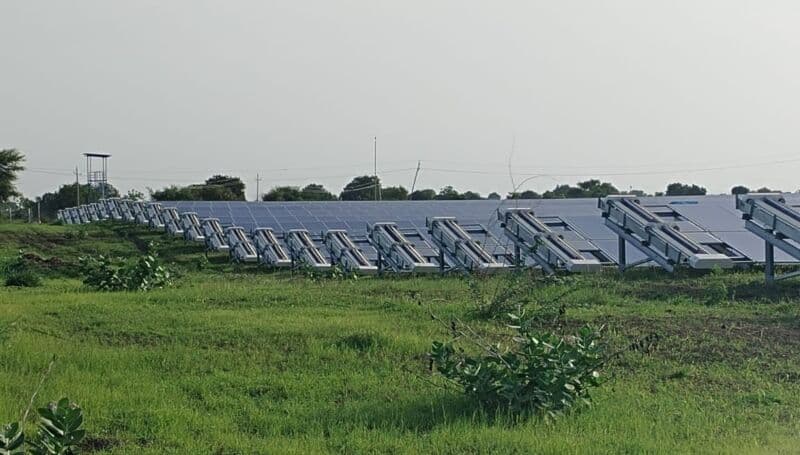Automatic Solar Panel Cleaning Robot:
MODEL-A

360° View of Model-A
Drag left or right to rotate and explore our Automatic Solar Panel Cleaning Robot from every angle
Loading 360° view... (0/61)
USPs
Conditions
Automatic Solar Panel Cleaning Robot Cost
& ROI Calculation
Projects with MODEL A – Automatic
Solar Panel Cleaning Robot
Installations
Schedule Online Demo For Automatic Solar
Panel Cleaning Robots
Let us help you

Features of Taypro's Automatic Solar Panel
Cleaning Robots: Model-A
AI-Enabled Waterless Cleaning Model-A
Extended Cleaning Range
Smart Weather Optimization
Advanced Remote Monitoring
Edge & Obstacle Detection Technology
Automatic Solar Panel Cleaning Robot
Model-A Specifications
| Specification | Details |
|---|---|
| Dimensions | 750 mm × 8800 mm (Max) |
| Cleaning Method | Waterless |
| Cleaning Type | Dual-Pass Cleaning |
| Cleaning Material | Microfiber Cloth |
| Cleaning Speed | 14 Meters/Minute |
| Max. Running Length | Up to 2.2 km |
| Recommended Running Length | 1.6 km |
| Wind Speed Resistance at Docking | 180 km/hr |
| Wind Speed Resistance in Operation | 55 km/hr |
| Max. Module Tilt | 45° |
| Max. Operating Temperature | 90°C |
| Max. East-West Slope | 15° |
| Max. Module Undulation | +-25 mm |
| IP Rating | IP65 |
| Corrosion Class | C5 |
| Battery Type | Lithium |
| Design Life | 20 Years |
| Weight | 45 Kg |
Advantages of Using Automatic Solar Panel
Cleaning Robots
Increased Energy Efficiency
Waterless Cleaning
Fully Autonomous & Smart Operation
Cost-Effective Solution
Safe and Reliable Operation
How Long Does It Take to Install the Automated Solar Panel Cleaning Robots?
The installation of the Solar Panel Cleaning Robot requires no modifications to the existing solar plant layout. The Model-A Automated Solar Panel Cleaning Robot is designed to operate directly on the panel frame.
The installation typically takes a few hours to a couple of days depending on the size of the solar plant. The solar panel cleaning robot installation process involves the placement of a docking station, configuration and calibration, and system integration.
For large-scale solar power plants, the installation may take from a few days to a week depending on the complexity of the layout. After the installation, the robots operate autonomously and do not need any manual intervention. TAYPRO provides complete dedicated support and assures the same-day breakdown resolution.
TAYPRO Model-A robots offer cost-effective and scalable solutions for solar power plants with easy installations and safe operations.
What Is the ROI for Installing the Automatic Solar Panel Cleaning Robot Model-A?
TAYPRO’s Model A Automatic Solar Panel Cleaning Robot delivers a high return on investment ROI by significantly increasing power generation.
Also, Model A reduces operational cleaning costs and offers long-term financial benefits. The initial investment is quickly recovered within one year, making it an effective and sustainable investment. You can calculate the ROI on Solar Panel Cleaning Robots by using theROI Calculator
How Does Automatic Solar Panel Cleaning Robot Work?
⦿ The robot initialises its sensors on the activation and performs the system checks connectivity with the central monitoring system
⦿ The cleaning schedule is pre-set via a remote monitoring portal which enables fully automated operation
⦿ The locomotion motor powers the movement and guides the robot along the solar panel frames
⦿ The cleaning brush motor starts and enables the waterless dual-pass cleaning technology with a microfiber cloth
⦿ The edge detection sensors continually scan the surroundings which prevents the robot from overshooting the panel edges
⦿ Users can adjust the cleaning speed and direction from the TAYPRO console
⦿ Once the cleaning cycle is complete, the robot returns to its docking station, where it recharges using solar energy and remains idle until the next scheduled cycle.
⦿ Advanced fault detection systems continuously analyse the robot parameters and if in case of any
⦿ The system ensures safe and efficient operations with features like obstacle detection, self-cleaning microfiber and adaptive navigation.




